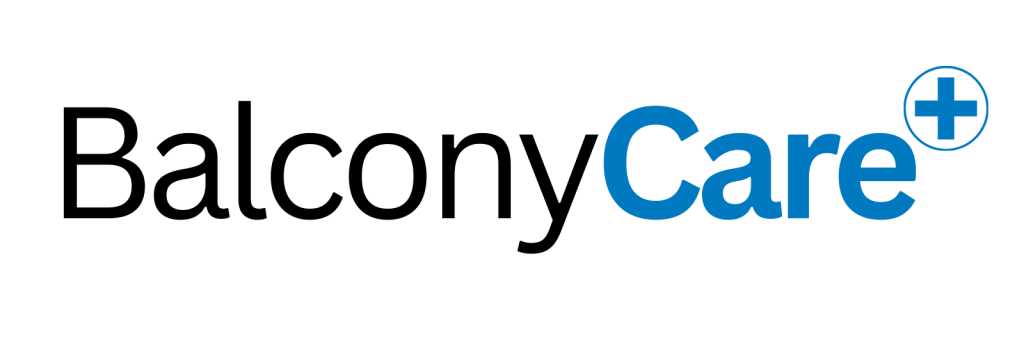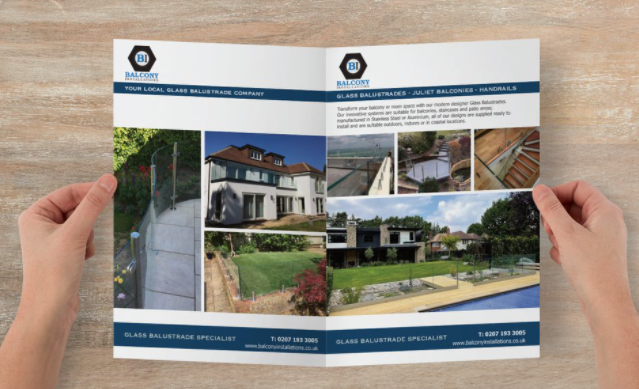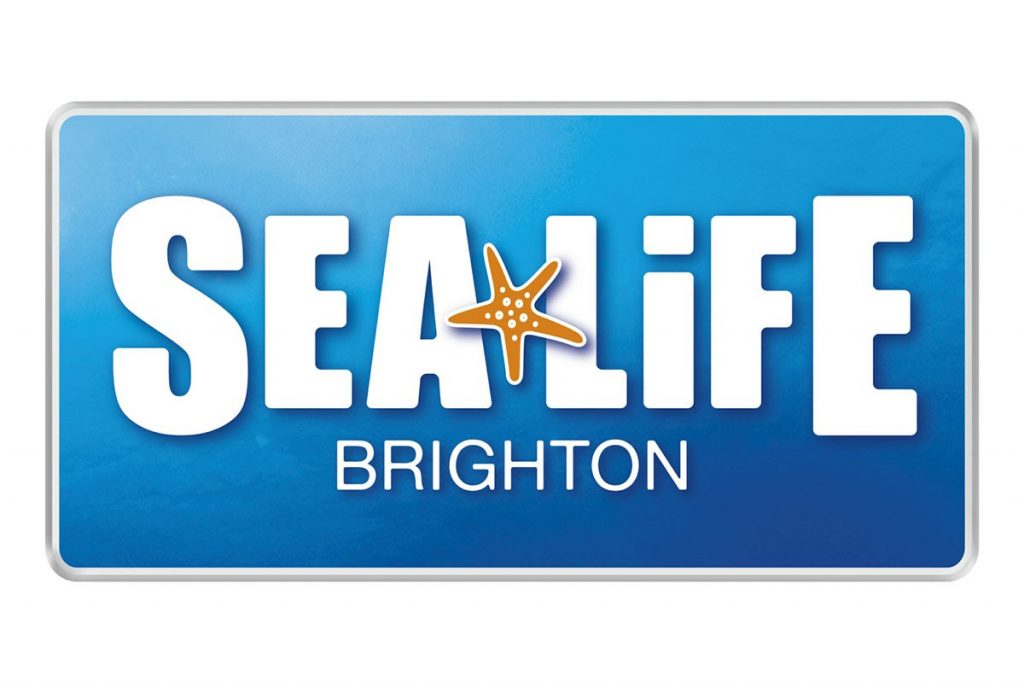Balcony Installations - FAQ
Knowledge Info
- What is a kN? (Kilonewton)
In the context of balustrades, kilonewtons (kN) are used to express the load capacity or strength of the balustrade system. For example, a residential glass balustrade designed to meet UK building regulations must be able to resist a horizontal line load of 0.74 kN/m in any direction at any point along the top edge of the balustrade. This is intended to simulate the force of someone leaning against or accidentally bumping into the balustrade.
The kN unit can also be used to specify the load capacity of the fixings that secure the balustrade to the structure. For instance, a balustrade system may require stainless steel fixings with a minimum breaking load of 5 kN to ensure the stability and safety of the balustrade.
- What is the weight of balustrade glass?
Here are the approximate weights per square meter (kg/m²) of the most common glass types for balustrades:
- 10mm toughened: 25kg/m²
- 12mm toughened: 30kg/m²
- 13.5mm laminated toughened: 33kg/m²
- 15mm toughened: 36kg/m²
- 17.5mm laminated toughened: 50kg/m²
- 21.5mm laminated toughened: 62kg/m²
- Stainless Steel fixings are too expensive, can I use zinc fixings outdoor instead to save in costs?
Using zinc bolts with stainless steel outdoor will lead to a galvanic corrosion. This occurs when two dissimilar metals are in contact with each other in the presence of an electrolyte, such as moisture or saltwater. In this situation, the more reactive metal (zinc in this case) will corrode more quickly, while the less reactive metal (stainless steel) will remain relatively unaffected.
As a result, if you use zinc bolts with stainless steel outdoors, the zinc bolts will corrode more quickly than expected, compromising the integrity of the joint or connection. To avoid this, it is recommended to use stainless steel bolts instead of zinc bolts when fastening stainless steel components.
Please inspect what types of fixings your installers will be using.
A corroded fixing can be dangerous and compromise the structural integrity of the object or structure it is securing. Corrosion can weaken the metal, reducing its load-bearing capacity and making it more prone to failure or collapse.
Corroded fixings can be a serious safety hazard, as they can cause structural failures, collapse of buildings or bridges, and other accidents. For example, corroded bolts or anchors holding up a balcony or staircase railing may break under normal loads, causing the railing to give way and leading to falls and injuries.
It is important to regularly inspect and maintain fixings in any structure or object to ensure they are secure and free from corrosion. If corrosion is found, the corroded fixings should be replaced immediately by a qualified professional to prevent potential accidents or structural failures.
- How can I prevent Galvanic Corrosion?
There are several ways to prevent galvanic corrosion, including:
- Material Selection: When possible, choose materials that are similar in their electrochemical activity to prevent galvanic corrosion. For example, using aluminum fasteners with aluminum materials or stainless steel fasteners with stainless steel materials.
- Coatings: Applying a protective coating, such as paint or powder coating, can act as a barrier to prevent the contact between different metals.
- Insulation: Using a non-conductive material, such as plastic or rubber, can prevent the contact between different metals and stop the electrochemical reaction that causes galvanic corrosion.
- Is Powder Coating the most durable paint?
Powder coating is generally considered one of the most durable paints available in the UK, due to its excellent resistance to abrasion, corrosion, and fading. Unlike traditional liquid paints, powder coating is applied as a dry powder and then baked onto the surface of the material, creating a hard and durable finish.
Compared to other types of paint, powder coating is less likely to chip, peel, or fade over time. It is also resistant to scratches and impact, making it ideal for use in high-traffic or harsh environments. Additionally, powder coating is available in a wide range of colours and finishes, including matte, glossy, and metallic, making it a popular choice for architectural, industrial, and automotive applications.
While there are other durable paints available in the UK, such as epoxy and polyurethane coatings, powder coating is often preferred for its superior durability, cost-effectiveness, and environmental benefits.
- Difference in Grades of Stainless Steel
There are many grades of stainless steel available for construction, each with unique properties and characteristics. Some of the most common grades used in construction include:
- Grade 304: This is the most commonly used grade of stainless steel in construction. It is highly versatile, easy to work with, and has excellent corrosion resistance.
- Grade 316: This grade of stainless steel is highly corrosion-resistant and is often used in harsh environments such as marine or coastal areas.
- Grade 430: This grade of stainless steel is less corrosion-resistant than grades 304 and 316 but is highly magnetic and has good thermal conductivity.
- Grade 2205: This is a duplex stainless steel that is highly resistant to corrosion, making it a popular choice for applications in chemical processing, oil and gas, and marine industries.
- Grade 17-4 PH: This is a precipitation-hardening stainless steel that is highly corrosion-resistant and has excellent strength.
- Grade 410: This is a martensitic stainless steel that is highly resistant to corrosion and is often used for applications such as fasteners and fittings.
- What is the advantage of having a Surveyor measure and inspect my balcony?
Employing a surveyor to measure your balcony is important for several reasons:
- Accuracy: Surveyors are trained professionals who have the expertise and equipment to take precise measurements. Measuring accurately is crucial for ensuring that the balustrade will fit properly and function as intended.
- Safety: Inaccurate measurements can lead to ill-fitting balustrades that pose a safety hazard.
- Cost-effectiveness: Measuring incorrectly can lead to costly mistakes. If the balustrade and glass don’t fit, you may need to reorder them or make adjustments to the balcony, which can be expensive and time-consuming.
- Compliance: Building regulations and planning permissions may require specific measurements for balustrades. Surveyors can ensure that the new installations meet these requirements and prevent any compliance issues.
In summary, employing a surveyor to measure your balustrades is important to ensure accuracy, safety, cost-effectiveness, and compliance with regulations.
- What is anodized aluminium?
Aluminum is anodized through a process that involves the use of an electrolytic solution, an electrical current, and an aluminum part or surface. Here are the basic steps involved in the anodizing process:
- Preparation: The aluminum surface is first cleaned and prepared to remove any dirt, oil, or other contaminants that could interfere with the anodizing process.
- Anodizing bath: The prepared aluminum part is then immersed in an electrolytic bath containing a sulfuric acid solution. The acid solution acts as an electrolyte, and the aluminum part serves as the anode (positive electrode) in the electrochemical reaction.
- Electrical current: A direct current is applied to the anodizing bath, and the aluminum part is connected to the positive terminal of the power source. As a result, a layer of aluminum oxide begins to form on the surface of the part.
- Anodizing process: The thickness of the aluminum oxide layer is controlled by adjusting the voltage and duration of the electrical current. The process can be stopped at any point to produce a desired thickness of oxide layer.
- Sealing: After anodizing, the aluminum part is rinsed in water to remove any remaining acid solution, and then sealed to prevent further oxidation. Sealing can be done through several methods, such as boiling the part in a water bath, immersion in a chemical bath, or through the use of a sealant coating.
The resulting anodized layer on the aluminum surface is hard, durable, and resistant to corrosion, abrasion, and wear. Anodized aluminum is widely used in a variety of applications, including architectural and construction, automotive, aerospace, and consumer products.
- What is Low Iron Glass?
Low iron glass, also known as extra clear glass or ultra-clear glass, is a type of glass that is made with a reduced amount of iron content. This results in a glass that is more transparent and has less of a greenish tint compared to regular glass.
Regular glass typically contains a small amount of iron, which gives it a slight greenish tint. However, in applications where a high level of transparency and clarity is desired, such as in architectural glazing, furniture, and displays, the greenish tint can be undesirable. This is where low iron glass comes in, as it can offer improved clarity and a more neutral color.
Low iron glass is made by using raw materials with a lower iron content, such as silica sand, soda ash, and dolomite, and by carefully controlling the manufacturing process. The result is a glass that has a higher light transmission, a greater color neutrality, and a higher level of transparency compared to regular glass.
Low iron glass can be used in a wide range of applications, including windows, doors, skylights, shower enclosures, furniture, displays, and more. It is particularly well-suited for applications where the aesthetic appearance and visual clarity of the glass are important.
- EVA or PVB laminated glass interlayer? which one is better for my balcony?
EVA (Ethylene-Vinyl Acetate) glass interlayer is generally considered to be more resistant than PVB (Polyvinyl Butyral) glass interlayer in certain outdoor applications, particularly in terms of resistance to moisture and environmental stress.
While both PVB and EVA offer excellent UV resistance and can withstand prolonged exposure to sunlight without yellowing or deteriorating, studies have suggested that EVA may offer better resistance to moisture and environmental stress than PVB. This could potentially result in a longer lifespan and better performance in certain outdoor applications.
- What are the KEY requirements to consider for a balustrade?
The requirements for balustrades in the UK are governed by Building Regulations. These regulations set out the minimum standards for the design and construction of balustrades in buildings to ensure they are safe and fit for purpose. Here are the key requirements for balustrades in the UK:
- Height: Balustrades must be at least 900mm in height above the pitch line of the adjacent stairway, ramp or floor. For a balcony or terrace, the height must be at least 1100mm.
- Strength: Balustrades must be designed and constructed to be structurally sound and able to withstand the imposed loads without collapsing or deflecting excessively.
- Gap size: The gap size between the balustrade elements (such as spindles or glass panels) must be designed so that they do not allow the passage of a 100mm sphere.
- Materials: Balustrades must be made from materials that are strong, durable, and weather-resistant, such as steel, aluminum, timber, or glass.
- Handrails: Stairways require handrails on at least one side if the stairway is less than 1000mm wide, or both sides if wider. Handrails should be at a height of at least 900mm.
- Glazing: Glass used in balustrades must be safety glass, such as toughened or laminated glass, and it must be able to withstand the imposed loads.
- Fixing: Balustrades must be securely fixed to the structure, using appropriate fixings that are strong and durable.
These are the key requirements for balustrades in the UK, but there may be additional requirements depending on the specific circumstances of the building or structure. It is always advisable to consult a qualified building professional to ensure that your balustrades meet all the necessary requirements.
- What is Self Cleaning Glass coating?
Generally, the self cleaning solutions you can apply to glass are “hydrophobic” solutions, which act as water repellents.
Self-cleaning glass nano coating hydrophobic is a type of coating that is applied to glass surfaces to make them more water-repellent. The coating contains nanoscale particles that create a hydrophobic (water-repelling) surface on the glass. This means that when water comes into contact with the glass, it beads up and rolls off the surface rather than spreading out and forming a film.
The hydrophobic surface also helps to prevent the accumulation of dirt and other contaminants on the glass. When water rolls off the surface, it takes the dirt and contaminants with it, leaving the glass clean and clear. The self-cleaning effect is enhanced by exposure to sunlight, which activates the nanoscale particles and helps to break down organic contaminants.
Self-cleaning glass nano coating hydrophobic can be applied to both interior and exterior glass surfaces, and it is particularly useful in areas that are exposed to rain, snow, or other types of moisture. It can also help to reduce the need for frequent cleaning and maintenance, which can be a significant cost and labor-saving benefit in commercial or industrial settings.
Overall, self-cleaning glass nano coating hydrophobic is an innovative and effective solution for maintaining the appearance and functionality of glass surfaces, while reducing the need for frequent cleaning and maintenance.
The protective effect may last between 6 months to a year depending on use and exposure.
Installation FAQ
- What are the KEY requirements to consider for a balustrade?
The requirements for balustrades in the UK are governed by Building Regulations. These regulations set out the minimum standards for the design and construction of balustrades in buildings to ensure they are safe and fit for purpose. Here are the key requirements for balustrades in the UK:
- Height: Balustrades must be at least 900mm in height above the pitch line of the adjacent stairway, ramp or floor. For a balcony or terrace, the height must be at least 1100mm.
- Strength: Balustrades must be designed and constructed to be structurally sound and able to withstand the imposed loads without collapsing or deflecting excessively.
- Gap size: The gap size between the balustrade elements (such as spindles or glass panels) must be designed so that they do not allow the passage of a 100mm sphere.
- Materials: Balustrades must be made from materials that are strong, durable, and weather-resistant, such as steel, aluminum, timber, or glass.
- Handrails: Stairways require handrails on at least one side if the stairway is less than 1000mm wide, or both sides if wider. Handrails should be at a height of at least 900mm.
- Glazing: Glass used in balustrades must be safety glass, such as toughened or laminated glass, and it must be able to withstand the imposed loads.
- Fixing: Balustrades must be securely fixed to the structure, using appropriate fixings that are strong and durable.
These are the key requirements for balustrades in the UK, but there may be additional requirements depending on the specific circumstances of the building or structure. It is always advisable to consult a qualified building professional to ensure that your balustrades meet all the necessary requirements.
- What fixings can I use to fix a balustrade channel to timber?
Most balustrade channels are not tested on timber, but this does not mean they can be fixed safely, it is just that tests are mainly carried out on concrete or steel. However, please consult your own engineer about the structure you are fixing to as some timber structures could be totally unsuitable for a balustrade.
Some common fixings that can be used include:
- Coach screws: Coach screws are large, heavy-duty screws with a hexagonal head and a sharp, pointed tip that can be used to fix the balustrade channel to the wooden structure. They are typically used for heavier loads or larger components.
- Through bolts: Through bolts are bolts that are inserted through a hole in the wooden structure and then tightened with a nut on the other side. They can be used to fix the balustrade channel to wooden structures where a very strong hold is required.
- Wood screws: Wood screws are designed specifically for use in wood, and are available in a range of sizes and types. They can be used to fix the balustrade channel to wooden structures where a moderate load is expected.
- Timber connectors: Timber connectors are metal brackets or plates that are designed to provide additional support and stability to wooden structures. They can be used to connect the balustrade channel to the wooden structure and are often used in conjunction with coach screws or lag screws.
It’s important to choose the right type and size of fixing for your specific application, and to ensure that they are installed correctly to provide a safe and secure fixing. It’s also important to follow the manufacturer’s instructions for the specific product you are using, and to ensure that the fixing is appropriate for the load and structure being supported. If you are unsure about the best fixings to use, it’s recommended to consult with a professional builder or engineer.
Maintenance FAQ
- What is Self Cleaning Glass coating?
Generally, the self cleaning solutions you can apply to glass are “hydrophobic” solutions, which act as water repellents.
Self-cleaning glass nano coating hydrophobic is a type of coating that is applied to glass surfaces to make them more water-repellent. The coating contains nanoscale particles that create a hydrophobic (water-repelling) surface on the glass. This means that when water comes into contact with the glass, it beads up and rolls off the surface rather than spreading out and forming a film.
The hydrophobic surface also helps to prevent the accumulation of dirt and other contaminants on the glass. When water rolls off the surface, it takes the dirt and contaminants with it, leaving the glass clean and clear. The self-cleaning effect is enhanced by exposure to sunlight, which activates the nanoscale particles and helps to break down organic contaminants.
Self-cleaning glass nano coating hydrophobic can be applied to both interior and exterior glass surfaces, and it is particularly useful in areas that are exposed to rain, snow, or other types of moisture. It can also help to reduce the need for frequent cleaning and maintenance, which can be a significant cost and labor-saving benefit in commercial or industrial settings.
Overall, self-cleaning glass nano coating hydrophobic is an innovative and effective solution for maintaining the appearance and functionality of glass surfaces, while reducing the need for frequent cleaning and maintenance.
The protective effect may last between 6 months to a year depending on use and exposure.
- My stainless steel handrails are showing some rust
If your stainless steel handrails are showing rust, it could be due to several reasons such as exposure to saltwater, prolonged exposure to moisture or humidity, or using cleaning agents that contain harsh chemicals. Here are some steps you can take to remove the rust and prevent it from recurring:
- Clean the surface: Use a mild soap and warm water to clean the surface of the handrails thoroughly. Make sure to remove any dirt, debris, or other contaminants that may be present on the surface. Rinse the surface with clean water and dry it completely with a towel.
- Remove the rust: Use a stainless steel rust remover, such as a paste or liquid, to remove the rust from the surface. Follow the instructions on the product label carefully, and wear protective gloves and eye goggles to avoid any contact with the product.
- Buff the surface: Once you have removed the rust, use a buffing pad or a clean cloth to buff the surface of the handrails. This will help to restore the shine and smoothness of the surface.
- Apply a protective coating: Apply a protective coating, such as a rust inhibitor or clear coat, to the surface of the handrails to prevent rust from forming again. Follow the instructions on the product label carefully and allow sufficient time for the coating to dry completely before using the handrails.
- Maintain regular cleaning: Regularly clean and maintain the handrails to prevent rust from forming again. Use mild soap and warm water to clean the surface and avoid using harsh chemicals or abrasive materials that could damage the surface.
By following these steps, you should be able to remove the rust from your stainless steel handrails and prevent it from recurring in the future.
- How do I clean my balcony glass panels?
You can follow these steps:
- Clear the area: Remove any objects or furniture from your balcony that might get in the way or obstruct your cleaning.
- Dust the glass: Use a soft-bristled brush or a dry microfiber cloth to remove any dust or debris from the glass surface.
- Apply cleaning solution: Mix a solution of warm water and a small amount of dish soap or a specialized glass cleaner. Apply the solution generously to the glass surface.
- Scrub the glass: Use a soft-bristled brush or a sponge to gently scrub the glass in a circular motion, starting from the top and working your way down.
- Rinse the glass: Use a bucket of clean water or a hose to rinse the glass surface thoroughly.
- Dry the glass: Use a squeegee or a clean microfiber cloth to remove any remaining water from the glass surface. Start from the top and work your way down, making sure to dry the edges and corners thoroughly.
- Finish up: If you notice any streaks or spots, use a clean, dry cloth to buff the glass until it’s completely clear.
It’s important to note that you should avoid cleaning balcony glass in direct sunlight or when it’s hot, as this can cause the cleaning solution to dry too quickly and leave streaks. Additionally, avoid using abrasive materials, such as steel wool or scrub brushes, on glass, as they can scratch the surface.
- How do I remove minor scratches from aluminium channels?
To remove scratches from aluminium channels, you can try the following methods:
- Sandpaper: Begin with a fine-grit sandpaper, such as 320-grit, and gently rub the scratch in a circular motion. Work your way up to a finer-grit sandpaper, such as 600-grit, until the scratch is no longer visible.
- Aluminum polish: Apply a small amount of aluminum polish to the scratched area and rub with a soft cloth until the scratch is no longer visible. Be sure to follow the manufacturer’s instructions for the polish you are using.
- Baking soda: Make a paste of baking soda and water and apply it to the scratched area. Rub gently with a soft cloth, then rinse with water and dry.
- Vinegar and water: Mix equal parts white vinegar and water and apply to the scratched area. Rub gently with a soft cloth, then rinse with water and dry.
It’s important to note that these methods may not work on deep scratches or gouges, and may not completely restore the appearance of the handrail. In some cases, it may be necessary to replace the damaged section of the handrail.
- How do I clean stainless steel handrails?
- Begin by wiping down the handrail with a soft, dry cloth to remove any loose dirt or debris.
- Next, use a mild soap and warm water solution to clean the handrail. Apply the solution with a soft, non-abrasive cloth, making sure to clean with the grain of the metal.
- For any stubborn stains, use a specialized stainless steel cleaner, following the instructions on the label. Be sure to rinse thoroughly with water and dry with a soft cloth.
- If there are any scratches on the surface of the handrail, you can use a stainless steel scratch remover to buff them out.
- Finally, to maintain the shine of the handrail, apply a thin coat of stainless steel polish using a clean, soft cloth, and buff to a shine.
Remember to always test any cleaning solution on a small, inconspicuous area of the handrail before using it on the entire surface to ensure it doesn’t cause any damage or discoloration.






